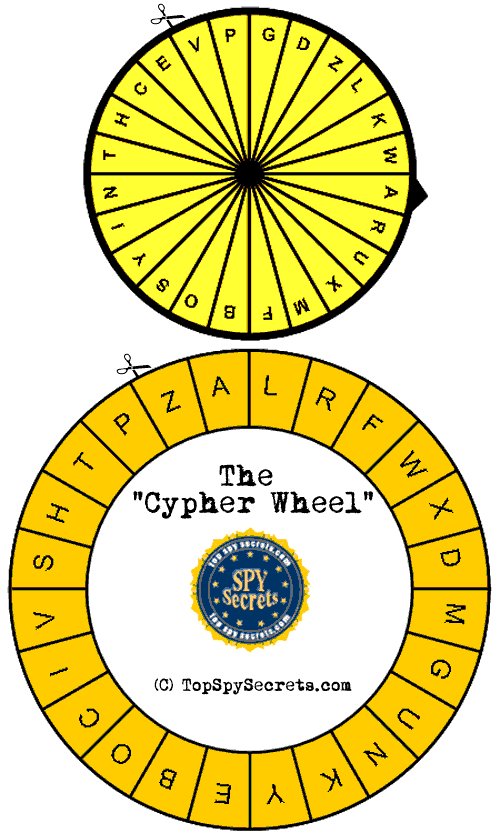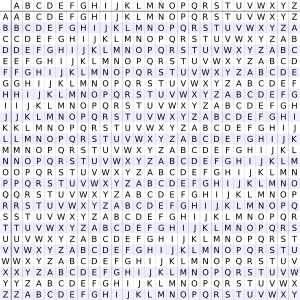In light of recent
news on the BYU Frontpage, there have been many advances, discoveries, and funds put towards hacking, code cracking and holding trade secrets secure. For one, my roommate claims he is very good (or was back in the day) at breaking into any computer he wishes that's attached to a network. This got me thinking, how am I going to secure my computer and my files to best his attempts? Maybe I'll try to secure my computer and one file and see if he can penetrate it sometime!
As Kacee was saying
yesterday, people have been the same over generations of time with typically the same worries. Although earlier people weren't trying to secure terabytes of data, they may have been protecting valuable secrets. Things of value that should not be disclosed to a select group whom the author chooses, he wishes to barricade his knowledge against their learning. Thus cryptography is born!
 |
Code your own message with a simple
pinwheel (from here). |
What is Cryptography? The word actually is greek for "hidden"+"writing" or "study" and we do have ancient examples of the Greeks using coded messages. It's medium is anything written and in it's basic form, it means to translate a message in a way that the message is unreadable to anyone but the intended reader who must translate into the original. Cryptography can be simple, such as a pinwheel with a principle letter or "key" that all the other letters align with, then the code can be decrypted. It can be something similar to the
Caesar Shift as Caesar in order to communicate with his generals would code his messages so that each letter in the message was shifted down the alphabet a set amount. He shifted by three.
It can also be mind numbingly difficult like the Vigenere square, invented by Leon Baptist Alberti (who I learned about in my Italian History class as the first "Renaissance Man"). Here, a Caesar shift is written down in a matrix so that each column represents the alphabet shifted a certain number of times. The coder chooses a message (e.g. "attackatdawn"), and a key word (e.g. "lemon"). The key is repeated until it is the same length as the plain text ("lemonlemonle"). From there you just take one letter at a time from the message and the key (L from the key, A from the message) and match the "L" row with the "A" column to get your first code letter (coincidentally and L!). When you're done your message will be LXFOPVEFRNHR. It's pretty hard to crack that!!!
 |
| Vigenere Square |
 |
An ancient Greek Skytale. This little instrument would have
you wrap your message in such a way that the lines matched
up. When literacy was uncommon, simple methods such as
this were adequate means of coding. |
How do you determine how much time and effort to put into a code ? I could jumble the words of a message all day, but how tough does it need to be to crack? This question may be solved by considering what the task is. Let's say we're are roman soldiers back in the 3rd century AD stationed in Brittania with knowledge of a mutiny army bent towards Italy. We wish to relay our knowledge to Rome but without the perpetrating general's knowledge. The message needs to be coded well enough that the messenger, should he be caught and questioned along his 1100 mile journey that nothing be revealed. Maybe the message should be hidden within a routine message that would calm any prying eyes. Armies, Diplomats and Majesties were the principle curators of coded messages for many centuries. However, those under fear of their text calling them out as heretics would eventually join the ranks among the greats of hiding a message within a message. The value of written knowledge is amply evident in the extent to which people will go to make it unreadable to all but intended eyes.




I've always found Cryptography to be so interesting! The power of the human brain to break complex codes and puzzles amazes me! In a way, I think our brains are wired to be inclined toward puzzles of logic and reasoning. Did any one ever do logical matrices in elementary school? That's what this post reminded me of. For those of you who don't know, a logic matrix is basically a large grid where different sections of the grid respond to different pieces of information. Usually you're trying to figure out different things about different imaginary people such as hair color, last name, anything! A set of clues accompanies the grid and using logical reasoning, you have to figure out what pieces of information go with which people. That was a horrible explanation, but they're really fun! Have you done those, Catherine?
ReplyDeleteActually, yes I have done some of those. In my anatomy class last year, we had the option of completing those puzzles after finishing a test for extra credit. I think that was the first time I actually finished one. I'm not very good at them.
ReplyDeleteThe main point would be not to lose the code. If you do that, then critical information is lost. Br. Burton told us about how when he was little kid he wrote a coded journal, but didn't write down the code, so now, years later, he doesn't remember the code and can't read any of the memories he thought important enough to write down.
Passwords become really important in codes like these, AND in protecting our data. I've learned that one of the most important password to keep secure is your email password, since a lot of other websites (including banks) send reset information to your email. You can even set up a supplementary password thingy--where they text your phone when you login, for more protection.
ReplyDeleteOf course, it's always important to keep your data backed up, or else your password doesn't really protect any thing.